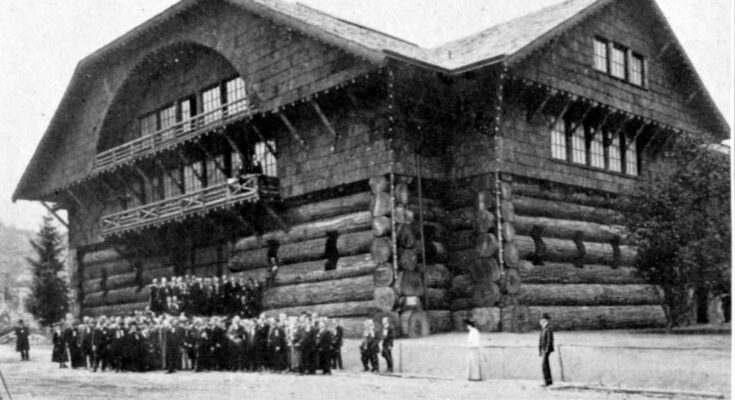In the heart of Portland, Oregon, once stood an architectural marvel renowned as one of the world’s largest log cabins. The Forestry Building, constructed in 1905 for the Lewis and Clark Exposition, was a breathtaking homage to the Pacific Northwest’s timber-rich heritage. Known as a “temple of timber,” the building was a remarkable example of early 20th-century log architecture, symbolizing the grandeur and economic importance of Oregon’s forestry industry.
The Forestry Building was constructed with colossal Douglas fir logs, some measuring six feet in diameter and stretching fifty-four feet in length. These immense timbers formed towering columns and intricate wooden arches, creating a cathedral-like interior that left visitors in awe. The building’s log facade harmonized beautifully with the surrounding forested landscape, reinforcing its connection to nature and Oregon’s identity as a timber powerhouse.
Inside the building, exhibits celebrated the region’s forestry resources and craftsmanship. Displays included massive logs, intricately handcrafted furniture, and samples of various woods found in the Pacific Northwest. Visitors marveled at the sheer size of the timber on display, along with the artistry that transformed raw materials into functional and decorative pieces. These exhibits highlighted both the natural beauty of Oregon’s forests and the economic opportunities they provided.
The Forestry Building was more than just an architectural feat; it was a symbol of regional pride. Its construction for the Lewis and Clark Exposition showcased the Pacific Northwest’s forestry industry on a global stage, attracting visitors and investors alike. The building’s design embodied a blend of utilitarian functionality and artistic elegance, making it a landmark not only for Portland but for the entire state of Oregon.
Tragically, this iconic structure met its end on August 17, 1964, when a fire consumed it entirely. The blaze quickly spread through the dry timbers, leaving no chance for recovery. While no lives were lost, the fire destroyed an irreplaceable piece of Portland’s history. Black-and-white photographs and vivid memories of the community are all that remain of this “temple of timber.”
The loss of the Forestry Building deeply affected the community. For nearly six decades, it had stood as a proud testament to Oregon’s natural heritage and its pivotal role in the timber industry. Its destruction marked the end of an era, as modern construction methods and materials replaced the massive log architecture of the past.
Today, the Forestry Building is remembered as a symbol of Oregon’s history and the awe-inspiring strength of its forests. It served as a tangible reminder of the state’s connection to its natural resources and its people’s ingenuity and craftsmanship. Though the building is gone, its legacy endures in the stories, photographs, and pride of a region that continues to honor its timber heritage.



